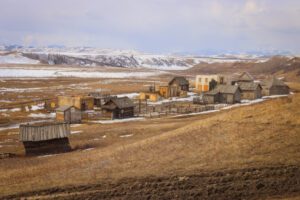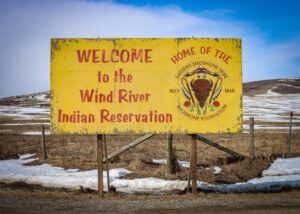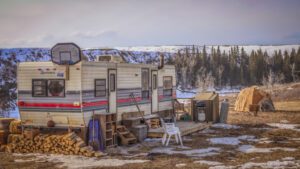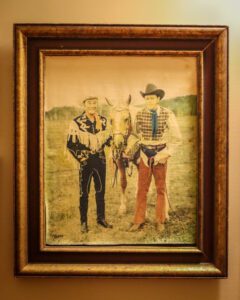

He has brought over a billion dollars worth of movie production work to the province of Alberta and has worked with numerous A-list actors and directors. Yet, he’s as humble as they come. Here’s why John Scott is the go-to man when it comes to creating movie magic in Canada.


By Jenn Webster, Photos by BAR XP PHOTOS
*As published in the July/August 2023 issue of WHR.
From Hallmark films, to indies, to episodic television and blockbusters, Alberta has seen a great deal of movie making in the province lately. Thanks to Alberta’s Film and Television Tax Credit (FTTC) created in 2020, Alberta is now on a level playing field with other Canadian provinces, making it an attractive place for movie productions. With all its beautiful mountainsides and diverse settings, the province is considered what is known as a “Goldilocks” zone environmentally.
Then, there is the talent and opportunity here and one man with the moxie for promoting Alberta to Hollywood.
That gentleman is John Scott.


FEATHER IN ALBERTA’S CAP
“1 week after the tax credit kicked in, over $500 million in movie business occurred in Alberta,” says John Scott. Standing in the alleyway of one of his barns, Scott’s land in Longview, AB, has hosted many film productions over the years. In fact, Brad Pitt has been to Scott’s home twice, so has Kevin Costner and Clint Eastwood, once. And whether you’re an A-list actor, or someone simply interested in talking about movies, Scott’s treats everyone with respect and his salt-of-the-earth demeanour puts you right at ease.
“They cleaned all the rental cars out of Calgary and once those were gone, filming companies had to start getting them from Edmonton. The fuel account on some movie sets is astronomical – for instance, the set of Billy The Kid requires $50,000 in fuel per week,” he explains.
Scott explains that movie productions have a large trickle-down effect on the economy of Alberta. Film sets require people, thus creating employment.
“There’s truly nothing like this business to keep people employed,” he states.


In fact, he says the spin-off of a movie dollar is roughly five or six, to one. That money goes to local hotels, restaurants, candy stores, western stores, hay dealers, farriers, fuel, lumber yards (because movie sets are always building things) and more.
“It all trickles down to help our economy,” Scott explains. “Things like propane. We have one picture that fills up work trucks twice a week with propane. One picture is using a lot skidoos, so local companies are seeing increased skidoo rentals. Hay sales. Horse shoes to go on the horses’ feet… Movie productions benefit everyone.”
Scott evens recalls the day he took a make-up artist into town and she spent $13,000 on products required for a picture in one afternoon.
HBO’s limited series, The Last of Us was filmed almost entirely in Alberta and as Scott describes it, “…put Calgary on the map.” It had a budget of $300 million.


Aside from the financial benefits, Scott say the film industry is also an environmentally friendly business and another form of tourism for the province. Especially in the case of The Last of Us, people from all over the world have started traveling in, to see where the popular series was filmed.Out of curiosity for a television show, tourists have chosen Alberta for a holiday.
“Years ago, they came in here in throngs after Legends of the Fall was filmed. It’s the cheapest form of tourism advertising that I can imagine and it’s exported across the world,” Scott states.
Unfortunately, an ongoing labor dispute resulting in a writer’s strike that began on May 2, 2023 between the Writers Guild of America (WGA) and the Alliance of Motion Picture and Television Producers (AMPTP) has thrown an unforeseen obstacle into Alberta’s current prosperity. A potential actor’s strike is also looming on the horizon, which will affect productions everywhere. However, Alberta remains an optimal location for movie productions, especially westerns. And once again, that’s where John Scott is an incredible asset.


Not only does the man have a large piece of land and idyllic river valley for crews to shoot, he also has a huge variety of actor-safe horses, museum-quality period tack, white bison and a diverse range of wagons, buggies, carriages, stagecoaches and chuckwagons from which to choose for shooting. He’s also been in the game since 1969. Scott first got his start as a wrangler, training and caring for horses on the set. Since then, he’s had more than 250 productions to his credit.
These have included six Academy Award winners; Unforgiven, Legends of the Fall, The Assassination of Jesse James, The Revenant, Days of Heaven and Shanghai Noon. Alberta can also claim another Academy Award in Brokeback Mountain, however during filming, Scott was in New Zealand working for The Lord of the Rings at the time.


Despite all the inspiring honours and places his work has taken him, Scott credits his success to the people and the horses by which he is surrounded.
“A lot of input goes into making a picture,” he says. “From the people responsible for food, to make-up, to stunt coordinators, to actors… they’re all important. They all have to work together in the background to make things work. And if they aren’t doing the job – then, the major actors have to reshoot.”
He explains that the process is similar to throwing a bunch of people into a melting pot and “hoping,” versus “making” things happen.
“The fact that Albertans have been willing and resilient enough to work long hours, in harsh temperatures do whatever is necessary to get the shot, speaks volumes about us,” Scott expresses. “We’ve been lucky to produce so many wonderful pictures and we’ve got some major accomplishments in the process. Which, will hopefully translate into future projects.”


THE HORSE CREW
Standing in the middle of his large equine herd (anywhere between 130 and 150 head), with the odd crunchy in his pocket for an affectionate few, Scott is quiet and undeniably proud of his horses. He has been building his herd to accommodate motion pictures since 1972. Ranging in colours, the group mostly consists of geldings and every one of them has a hoof number.
“I hoof number every horse, because sometimes you can have six black horses that really just look the same. And then you send a wrangler to grab a black horse… it’s easier just to give them the hoof number,” he chuckles
He divides his horses into four main categories. These consist of; cast horses (those specified for actors); doubles, (similar-looking horses to the ones cast as actor horses); teamsters; and stunt horses.


“Cast horses need to be extremely safe and are strictly designated for actors (these ones must be nearly ‘bombproof,’ to be really safe.) Teamsters are the ones used to pull wagons and such, and finally, some are stunt horses. Double horses are the horses assigned to duplicate the cast horses – they might require make-up or prosthetics – whatever it takes to make them look like the first one,” Scott explains.
“For Billy The Kid we have a gray horse. He’s the hero-coloured horse. With lighter coloured mounts, your eye is drawn to them on screen. And if it’s an outlaw picture, you really want to put your characters on dark horses.”
The horses that Scott can provide are a major asset for film productions in Alberta. In combination with the scenery on his land and the western towns, corrals and medley of other buildings, he has everything a film crew could possibly dream of to make a movie.
“If we do things right and don’t overcharge, we will hopefully bring other big productions to Alberta in 2023. There is a very big western looking at us for next year! If so, it will employ a lot of people,” says Scott.


